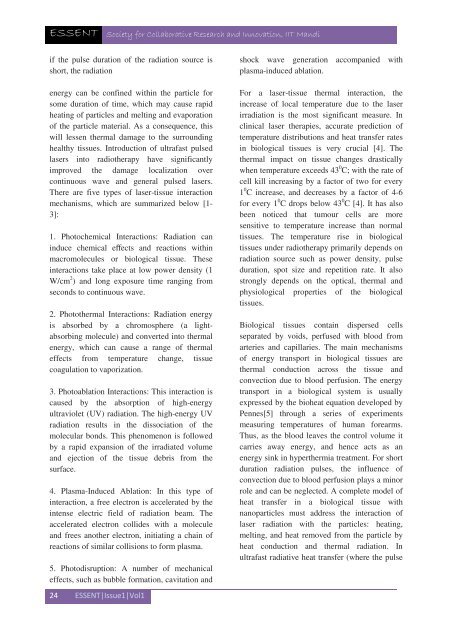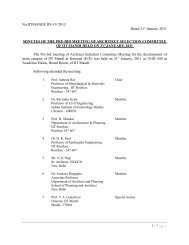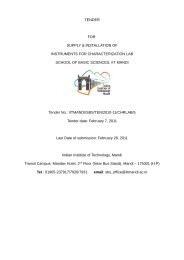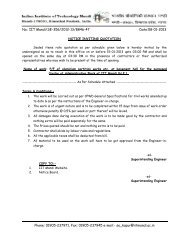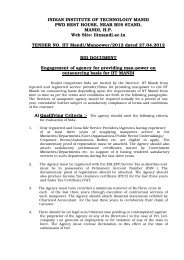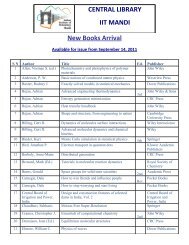Issue1. Vol.1 (April, 2013) - IIT Mandi
Issue1. Vol.1 (April, 2013) - IIT Mandi
Issue1. Vol.1 (April, 2013) - IIT Mandi
- No tags were found...
Create successful ePaper yourself
Turn your PDF publications into a flip-book with our unique Google optimized e-Paper software.
ESSENT Society for Collaborative Research and Innovation, <strong>IIT</strong> <strong>Mandi</strong>if the pulse duration of the radiation source isshort, the radiationenergy can be confined within the particle forsome duration of time, which may cause rapidheating of particles and melting and evaporationof the particle material. As a consequence, thiswill lessen thermal damage to the surroundinghealthy tissues. Introduction of ultrafast pulsedlasers into radiotherapy have significantlyimproved the damage localization overcontinuous wave and general pulsed lasers.There are five types of laser-tissue interactionmechanisms, which are summarized below [1-3]:1. Photochemical Interactions: Radiation caninduce chemical effects and reactions withinmacromolecules or biological tissue. Theseinteractions take place at low power density (1W/cm 2 ) and long exposure time ranging fromseconds to continuous wave.2. Photothermal Interactions: Radiation energyis absorbed by a chromosphere (a lightabsorbingmolecule) and converted into thermalenergy, which can cause a range of thermaleffects from temperature change, tissuecoagulation to vaporization.3. Photoablation Interactions: This interaction iscaused by the absorption of high-energyultraviolet (UV) radiation. The high-energy UVradiation results in the dissociation of themolecular bonds. This phenomenon is followedby a rapid expansion of the irradiated volumeand ejection of the tissue debris from thesurface.4. Plasma-Induced Ablation: In this type ofinteraction, a free electron is accelerated by theintense electric field of radiation beam. Theaccelerated electron collides with a moleculeand frees another electron, initiating a chain ofreactions of similar collisions to form plasma.5. Photodisruption: A number of mechanicaleffects, such as bubble formation, cavitation and24 ESSENT|Issue1|Vol1shock wave generation accompanied withplasma-induced ablation.For a laser-tissue thermal interaction, theincrease of local temperature due to the laserirradiation is the most significant measure. Inclinical laser therapies, accurate prediction oftemperature distributions and heat transfer ratesin biological tissues is very crucial [4]. Thethermal impact on tissue changes drasticallywhen temperature exceeds 43 0 C; with the rate ofcell kill increasing by a factor of two for every1 0 C increase, and decreases by a factor of 4-6for every 1 0 C drops below 43 0 C [4]. It has alsobeen noticed that tumour cells are moresensitive to temperature increase than normaltissues. The temperature rise in biologicaltissues under radiotherapy primarily depends onradiation source such as power density, pulseduration, spot size and repetition rate. It alsostrongly depends on the optical, thermal andphysiological properties of the biologicaltissues.Biological tissues contain dispersed cellsseparated by voids, perfused with blood fromarteries and capillaries. The main mechanismsof energy transport in biological tissues arethermal conduction across the tissue andconvection due to blood perfusion. The energytransport in a biological system is usuallyexpressed by the bioheat equation developed byPennes[5] through a series of experimentsmeasuring temperatures of human forearms.Thus, as the blood leaves the control volume itcarries away energy, and hence acts as anenergy sink in hyperthermia treatment. For shortduration radiation pulses, the influence ofconvection due to blood perfusion plays a minorrole and can be neglected. A complete model ofheat transfer in a biological tissue withnanoparticles must address the interaction oflaser radiation with the particles: heating,melting, and heat removed from the particle byheat conduction and thermal radiation. Inultrafast radiative heat transfer (where the pulse


